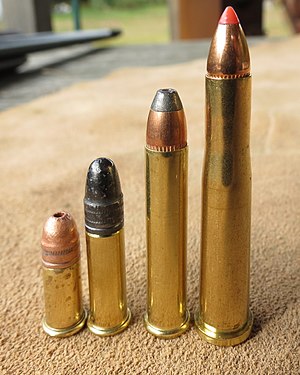.22 Hornet
| .22 Hornet | ||||||||||||||||||||||||
|---|---|---|---|---|---|---|---|---|---|---|---|---|---|---|---|---|---|---|---|---|---|---|---|---|
 From the left, a .22 Short, .22 LR, .22 Winchester Magnum, and a .22 Hornet with Hornady 40 gr (2.6 g) VMax bullet, respectively | ||||||||||||||||||||||||
| Type | Rifle respectively | |||||||||||||||||||||||
| Place of origin | United States | |||||||||||||||||||||||
| Service history | ||||||||||||||||||||||||
| In service | 1930-present | |||||||||||||||||||||||
| Used by | USAAF | |||||||||||||||||||||||
| Wars | World War II | |||||||||||||||||||||||
| Production history | ||||||||||||||||||||||||
| Designer | Townsend Whelen / G. L. Wotkyns | |||||||||||||||||||||||
| Designed | 1920's | |||||||||||||||||||||||
| Manufacturer | Winchester | |||||||||||||||||||||||
| Produced | 1930 - Present | |||||||||||||||||||||||
| Variants | .22 Hornet Ackley, .22 K-Hornet | |||||||||||||||||||||||
| Specifications | ||||||||||||||||||||||||
| Parent case | None | |||||||||||||||||||||||
| Bullet diameter | .224 in (5.7 mm) | |||||||||||||||||||||||
| Neck diameter | .243 in (6.2 mm) | |||||||||||||||||||||||
| Shoulder diameter | .276 in (7.0 mm) | |||||||||||||||||||||||
| Base diameter | .298 in (7.6 mm) | |||||||||||||||||||||||
| Rim diameter | .350 in (8.9 mm) | |||||||||||||||||||||||
| Rim thickness | .065 in (1.7 mm) | |||||||||||||||||||||||
| Case length | 1.403 in (35.6 mm) | |||||||||||||||||||||||
| Rifling twist | 1-14 | |||||||||||||||||||||||
| Primer type | small rifle | |||||||||||||||||||||||
| Ballistic performance | ||||||||||||||||||||||||
| ||||||||||||||||||||||||
| Test barrel length: 24 inches Source(s): Hodgdon[1] | ||||||||||||||||||||||||
The .22 Hornet is a vermin, small-game and predator centerfire rifle cartridge. It is considerably more powerful than the .22 WMR and the .17 HMR, achieving higher velocity with a bullet twice the weight. The Hornet also differs very significantly from these in that it is not a rimfire but a centerfire cartridge. This makes it handloadable and reloadable, and thus much more versatile. It was the smallest commercially available .22 caliber centerfire cartridge until the introduction of the FN 5.7x28mm.
The .22 Hornet fills the gap between such popular varmint/predator cartridges as the .22 WMR and the .223 Remington. In regard to muzzle velocity, muzzle energy and noise, it is well suited to vermin and predator control in relatively built-up areas. The Hornet's virtual absence of recoil has made it even quite popular among deer hunters in some areas, although it is generally regarded as very underpowered for deer unless bullet placement is absolutely precise. Many jurisdictions such as the Netherlands, the UK and some states in the USA currently prohibit the Hornet for use on deer.
The .22 Hornet is also known as 5.6x35mmR.[2]
History
The .22 Hornet's ancestry is generally attributed to experiments done in the 1920s using the black-powder .22 WCF at Springfield Armory.[2] Winchester adopted what had so far been a wildcat cartridge in 1930, producing ammo for a cartridge for which no commercially made guns yet had been built. It wasn't until 1932 that any company began selling commercially made guns for the cartridge.
Older guns generally have a slower twist rate of 1-16" (or one turn in every 16 inches (410 mm) of barrel length) for lighter bullets with a .223 caliber dimension. Newer guns feature a faster 1-14" twist in the .224 bore diameter.
Beginning during World War II, aircrew survival rifles in .22 Hornet were developed and issued by the U.S. military. They typically were bolt-action rifles with telescoping stocks (M4 Survival Rifle) or break-open rifle/shotgun over-under designs (M6 Aircrew Survival Weapon). Military survival issue .22 Hornet ammunition was loaded with soft-point expanding jacketed bullets, not complying with the Hague Convention. However, they were labeled "Under no circumstances is the ammunition to be used for offensive or defensive measures against enemy personnel. This ammunition is provided for use with your emergency survival Rifle for the Killing of Game for food under emergency survival conditions only."[3]
-
Disclosure
-
.22 Hornet Box
Rifles are currently (2007) being chambered in .22 Hornet by Ruger, New England Firearms, CZ and various other mass-market manufacturers. Most current-production rifles in .22 Hornet are either bolt-action or single-shot designs, with the exception of a very few "survival" rifle/shotgun over-under designs such as the Savage Model 24 from Savage and a few European-made kipplauf break-action, single-shot rifles. It is possible to get an extremely accurate new .22 Hornet rifle for as little as US$200, although prices can go much higher for rifles made by custom riflemakers and the specialist London and European trade.
Revolvers have been produced in .22 Hornet by Taurus, Magnum Research, and others. Single-shot pistols in .22 Hornet have been made by Thompson. (Power levels are somewhat less for this cartridge in short-barrelled handguns than in rifles.)
Wildcat variants of the .22 Hornet, such as the .22 K-Hornet, can boost bullet velocity and energy considerably above factory .22 Hornet levels, but performance still falls short of what is deer-legal in the Netherlands or any part of the United Kingdom.
Performance
Factory ammunition is widely available from all major manufacturers, generally with bullets weighing 34, 35, 45, or 46 grains (2.2, 2.3, 2.9, 3.0 g), with bullets invariably either hollow point or soft point. Muzzle velocity typically is in the 2,500 to 3,100 ft/s (760 to 940 m/s) range, and muzzle energy is just over 700 ft·lbf (950 J) for factory ammo fired from a rifle. (Velocities and energies are less when Hornet ammunition is fired from short-barrelled firearms.)
Published handload data from major handloading-product companies shows how versatile the .22 Hornet can be. According to the Hodgdon reloading data, the heavier bullets show a serious affinity for Lil'Gunpowder to produce much higher velocities than other powder with heavy bullets in this small case.[1]
See also
References
- ^ a b .22 Hornet load data at Hodgdon
- ^ a b Barnes, Frank C. (1997) [1965]. McPherson, M.L. (ed.). Cartridges of the World (8th Edition ed.). DBI Books. p. 16. ISBN 0-87349-178-5.
{{cite book}}:|edition=has extra text (help) - ^ .22 Hornet article at the Reload Bench


